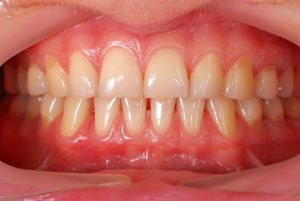The Different Kinds of Gum Disease Treatment with a Periodontist
August 6, 2017
 Like all dental problems, gum disease occurs on a spectrum– from mild to severe. The kind of treatment a patient requires depends directly on the severity of their gum disease, and today, your periodontist is going to discuss the different procedures they can use to help patients with varying needs.
Like all dental problems, gum disease occurs on a spectrum– from mild to severe. The kind of treatment a patient requires depends directly on the severity of their gum disease, and today, your periodontist is going to discuss the different procedures they can use to help patients with varying needs.
Treating Mild Gum Disease
The first stage of gum disease is called gingivitis, and it is characterized by the gums being red, tender, swollen, and they likely bleed very easily when a patient brushes their teeth.
At this point, the disease can mostly be managed with better oral hygiene at home, consisting of brushing and flossing while making it a point to clean along the gum line. However, this isn’t a substitute for a complete periodontal cleaning performed by a periodontist.
A periodontal cleaning is very similar to a regular dental cleaning like with your general dentist, except there is an emphasis on cleaning around the gum line. If you are experiencing the initial signs of gum disease, it’s always a good idea to contact a periodontist to see if you need more treatment than what you can accomplish at home.
Treating Advanced Gum Disease
If left untreated, gum disease can advanced to its next stage, called periodontitis. At this point, the bacterial infection is starting to break down the bone supporting the teeth, so patients will likely experience gum recession, loose teeth, and eventually, tooth loss.
Fortunately, there are a number of treatments that can be used to address this problem.
Initially, your periodontist will probably use something called a “deep cleaning.” This consists of two different procedures known as scaling and root planing. Using either dental instruments or an ultrasonic device, they’ll start by breaking up and clearing away plaque and tartar from the tooth surfaces and beneath the gum line (scaling). Root planing is then used to smooth out the rough surfaces of the teeth’s roots, discouraging the further buildup of tartar, plaque, and bacteria.
In addition to this, your periodontist may also choose to apply antibiotic therapy to further fight the infection. This may consist of a topical antibiotic applied in the office or a prescription mouthwash you’ll use at home.
If it is necessary to remove any infected tissue, then they’ll use what is called LANAP, which stands for “Laser Assisted New Attachment Procedure.” Using the laser’s extremely concentrated beam of light, your periodontist can quickly and painlessly remove infected gum tissue while leaving the surrounding healthy tissue completely untouched. The instrument generates almost no heat and even cauterizes blood vessels as it goes, so a patient will experience very little discomfort or bleeding during their treatment, which is a great step forward compared to traditional periodontal surgery.
Final Thoughts
All in all, the best approach is to simply take care of your teeth and gums the best you can at home, and if you show any signs of gum disease, promptly contact a periodontist so they can treat the infection before it becomes more serious. With this, you can trust that gum disease will never have a chance to impact your smile.
About the Author
Dr. Stephen Grossman is a board-certified periodontist, and he was one of the first doctors in Massachusetts to be trained and certified to provide periodontal laser surgery for Concord patients. If you are experiencing any gum disease-related symptoms, he can be contacted through his website or by phone at (978) 263-1313.
No Comments
No comments yet.
RSS feed for comments on this post.
Sorry, the comment form is closed at this time.

